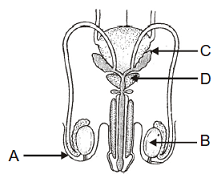The National Eligibility cum Entrance Test (NEET) is a national-level medical entrance exam conducted by the National Testing Agency for admission to MBBS and BDS courses. NEET is a mandatory exam for admission to all government and private medical and dental colleges in India . NEET is a pen and paper-based exam that is conducted once a year. Around 8 to 10 lakh candidates appear for NEET every year and compete for around 1 lakh medical and dental seats all across the country.
💓💓💓DAILY✕45💓💓💓💓
😀
1.Which of the following gland stimulates the pituitary to release the hormone responsible for parturition?
a)Neuroendocrine gland

b)Pancreas
c)Salivary
d)Gall bladder
TOPIC:
Parturition is induced by a complex neuroendocrine mechanism. The signals for parturition originate from the fully developed fetus and the Placenta which induces mild uterine contraction called fetal ejection reflex. This triggers the release of oxytocin from the maternal pituitary.
😀
2.Identify A, B, C, and D in a given diagram and select the correct statement.

a. A is analogous to the labia majora of female
b. B is a male primary sex organ that produces male gamete and secretes gonadotropic hormones
c. C is a male accessory gland that forms 60-70% of the volume of semen
d. D is also male accessory gland and its secretion helps in activation of sperms

a. A is analogous to the labia majora of female
b. B is a male primary sex organ that produces male gamete and secretes gonadotropic hormones
c. C is a male accessory gland that forms 60-70% of the volume of semen
d. D is also male accessory gland and its secretion helps in activation of sperms
a)a, b & d
b)c & d
c)b, c & d
d)a, b, c & d

Explanation
In the above diagram,
A= Vas deference, B=testis/testicles, C=seminal vesicle, D=prostate gland
a- Scrotum is analogous to the labia majora of female
b- Testis is male primary sex organ which produces male gamete and secretes gonadotropic hormones
c- seminal vesicle is a male accessory gland which forms 60-70% of the volume of semen. Sperm make up only 5 percent of the final volume of semen, the thick, milky fluid that the male ejaculates. The bulk of semen is produced by three critical accessory glands of the male reproductive system: the seminal vesicles, the prostate, and the bulbourethral glands.
d- Prostat gland is also male accessory gland and it produces prostatic fluid. This acidic fluid makes up about 20-30% of the semen. It also contains proteins with antibiotic properties that help prevent infections in the male reproductive tract.
A= Vas deference, B=testis/testicles, C=seminal vesicle, D=prostate gland
a- Scrotum is analogous to the labia majora of female
b- Testis is male primary sex organ which produces male gamete and secretes gonadotropic hormones
c- seminal vesicle is a male accessory gland which forms 60-70% of the volume of semen. Sperm make up only 5 percent of the final volume of semen, the thick, milky fluid that the male ejaculates. The bulk of semen is produced by three critical accessory glands of the male reproductive system: the seminal vesicles, the prostate, and the bulbourethral glands.
d- Prostat gland is also male accessory gland and it produces prostatic fluid. This acidic fluid makes up about 20-30% of the semen. It also contains proteins with antibiotic properties that help prevent infections in the male reproductive tract.
😀
3.If mammalian ovum fails to get fertilized, which one of the following is unlikely ?
Explanation
If the mammalian ovum fails to fertilize, choices (a) & (b) are obvious. Since corpus luteum declines so progesterone also decreases rapidly (progesterone is essential for maintenance of pregnancy). Also estrogen continues to cause growth of the endometrium which ultimately becomes thick enough to break down & cause menstruation. Hence choice. (c) is incorrect as estrogen secretion does not decrease further. Primary follicles continue developing irrespective of ovulatory condition.
😀
4.Heterogametic male condition does not occur in
Explanation
In birds usually female is designated as ZW, being heterogametic and male is designated as ZZ being homogametic.
😀
5.The parts of male urethra are
Explanation
Urethra carries urine from the bladder, as well as sperm from the vasa deferential through the penis. Urethra is a thick - walled, muscular duct and it is a common passage for both urine and semen; and called urinogenital duct. Urethra includes three parts - prostatic urethra, membranous urethra and penile urethra.
Key Concepts
😀
6.Phallic organs in cockroach are related to
😀
7.Testis is





 Most Important
Most Important 

